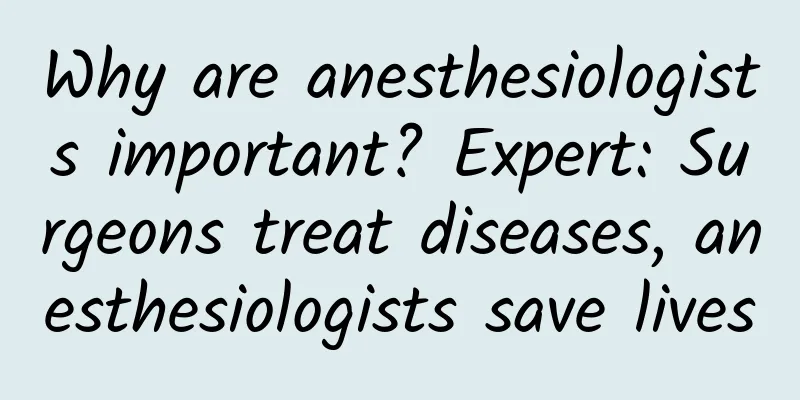Why are anesthesiologists important? Expert: Surgeons treat diseases, anesthesiologists save lives

|
A foreign president went on a visit abroad and only brought two medical personnel with him, one anesthesiologist and one anesthesia nurse. Why? Because the president has always been in good health. The "business trip" only prevents temporary respiratory arrest or personal injury caused by some emergency accidents. At this time, it is necessary to ensure that the airway is unobstructed, the breathing is sufficient, the heart beats normally, and the blood pressure is normal. As an anesthesiologist with certain surgical skills and the ability to sedate, relieve pain, and stabilize the patient's vital signs, it is very necessary. In recent years, the development of anesthesia in my country has been changing with each passing day, and has progressed from a "green train" led by a locomotive to a "high-speed train". Because each carriage of the high-speed train has power, as the hub and metronome of the hospital, anesthesia plays an important role in many links in the hospital and has become a propeller to promote the rapid recovery of patients after surgery. The origin of anesthesia Professor Li Tianzuo, Party Secretary and Director of the Anesthesiology Center of Beijing Century Altar Hospital Affiliated to Capital Medical University: More than 100 years ago (1846), after the advent of ether, humans really began to use surgical treatment to treat diseases. Before that, there was no anesthesia, and surgery was simply unimaginable. No matter what various methods were used before, they were at most pain relief, not anesthesia. Only after the advent of ether did anesthesia enter a new era. It was also because of anesthesia that surgery began to become an important treatment method. Modern anesthesia is not just about pain relief, but also about protecting the patient's life. With general anesthesia, I finally dare to do a painless gastroenteroscopy! Professor Wang Tianlong, Director of the Department of Anesthesiology, Xuanwu Hospital, Capital Medical University: Comfortable medical care was proposed 10 years ago by the discipline of anesthesiology. The discipline of anesthesiology should be built into a hub discipline of comfortable medical care, and five major discipline development visions were proposed. I have summarized the comfortable medical care, which is mainly reflected in two aspects: First, it is reflected in the comfortable medical care outside the operating room. In the past, gastroenteroscopy was painful for ordinary people. Now the number of painless gastroenteroscopy is increasing by 10%-15% every year, and it will continue to rise. On the other hand, in perioperative medicine, accelerated postoperative recovery is our concentrated expression in comfortable medical care after years of active research and clinical practice. In the past, after the patient entered the operation, he was either sent to the ICU or had to starve and thirst for several days after the operation, which was very uncomfortable. Now with the advent of accelerated postoperative recovery, what it looks like before entering the operating room and what it looks like when leaving the operating room is the same as before the operation. In fact, behind this is the discipline of anesthesia. Our medical staff have continuously practiced and developed, and applied many comfort measures in it, so as to achieve such a good effect. Surgeons treat diseases, anesthesiologists save lives Professor Feng Yi, Director of the Department of Anesthesiology and Pain Medicine at Peking University People's Hospital: There was once a legend that the mortality rate was 300%. Because there was no anesthesia, the operation had to be done quickly. The flying knife cut the assistant's neck and caused sepsis and death. The patient died of excessive blood loss, and the people watching the operation were also scared to death. Although this is just a legend, it shows how dangerous and "brutal" the operation was when there was no anesthesia. With the continuous advancement of anesthesia technology and surgical technology, the perioperative mortality rate has been reduced to a few thousandths or even a few ten thousandths. Many surgical restrictions and taboos before have been carried out smoothly due to the escort of anesthesia. To give a simple example, everyone knows that organ transplantation has several important organs, such as the heart, lungs, and liver. During the transplantation process, the diseased organ must be removed and the new organ must be transplanted. During this process, the patient will have no organ function for half an hour or even several hours. When there is no heart, lungs, or liver, how can this life be maintained? In fact, medicine can indeed ensure the safety of patients' lives during this time through drugs and auxiliary instruments, and a large part of the work is done by anesthesiologists. This is the meaning of saving lives. What? The surgery is over? I just took a nap! Professor Liu Kexuan, Director of the Anesthesia and Surgery Center of Nanfang Hospital of Southern Medical University: Anesthesia, in simple terms, is to achieve the goal of painless and safe surgery for patients through drugs and other methods. When we achieve this goal, we must provide patients with sedation, analgesia and muscle relaxation. These are the three elements of anesthesia that we often talk about. Sedation refers to the use of drugs to relax the patient's consciousness and put him into a sleep state or even lose consciousness, so that the patient does not experience the scene of the operation; analgesia means that the surgeon must remove and cut the corresponding surgical site, such as the lesion, which will cause pain and stress response. Strong pain and strong stress response can lead to some nerve reflexes, which will lead to the release of some harmful substances and damage the patient's body. At this time, analgesics are used to suppress the occurrence of these stresses. Muscle relaxation, also known as muscle relaxation, aims to provide surgeons with good surgical conditions and vision. Can I trust myself to the anesthesiologist? Professor Chen Xiangdong, Director of the Department of Anesthesiology, Union Hospital, Tongji Medical College, Huazhong University of Science and Technology: Every anesthesiologist has done a lot of work in his career. First, it takes a long time of professional learning and standardized training to become an independent anesthesiologist; second, it is necessary to accept a strict safety and quality control management system to ensure the accuracy and seriousness of the work of anesthesiologists and greatly reduce the risk of anesthesia; third, strengthen case discussion and cross-departmental communication and learning, and actively participate in continuing education, training and academic lectures. Such uninterrupted continuing education and learning ensures the high quality and high level of anesthesiologists, and is also a powerful means to reduce anesthesia risks; fourth, with the rapid development of anesthesia, anesthetic drugs and anesthesia equipment are constantly changing and improving. As an anesthesiologist, in addition to being familiar with the drugs and equipment used, you should also increase investment in the field of clinical research to promote the continuous progress of anesthesia. Why is anesthesia linked to efficiency? Professor Zhang Liangcheng, Director of the Department of Anesthesia and Surgery, Union Hospital Affiliated to Fujian Medical University: In the process of medical reform, the country has continuously emphasized the improvement of medical quality, and will assess the proportion of minimally invasive surgery, level 4 surgery, and day surgery in hospitals. Day surgery can reduce medical expenses, reduce hospital stays, and better promote rehabilitation. The role of anesthesiologists in this process, in addition to using the most appropriate drugs to reduce drug-related complications, also includes anesthesia-related operation techniques, and reducing postoperative complications, which can greatly reduce medical insurance costs, economic consumption, patient psychology, and medical resources. The concept of laparoscopic surgery is minimally invasive, muscle relaxation can provide a better surgical environment and field of view, and muscle relaxation can be reversed by muscle relaxant antagonists after surgery, so that respiratory and motor functions can be quickly restored, allowing patients to better return to their physiological state before anesthesia surgery. Level 4 surgery is characterized by relatively large surgical complexity, greater damage and interference to patients, and the more complex the surgery, the greater the support required, and the greater the relevant knowledge and technical support that anesthesiologists need to provide. Therefore, the relevant management departments need anesthesiologists to participate in more work on the assessment indicators of each hospital, and higher-quality anesthesia work is needed to provide support and support in this regard. |
>>: Purple spots on your body? It's not an allergy!
Recommend
What food is good to eat when you are four months pregnant?
The beginning of pregnancy is a relatively import...
Why is it easy to get angry during pregnancy
In fact, the weather at this time is a special se...
What changes occur in the uterus before menstruation?
We all know that women's menstruation flows o...
What can't you eat if you have ovarian cysts?
In recent years, the incidence of ovarian cysts i...
Symptoms of adenomyosis and fibroids
I believe everyone knows the importance of the ut...
After a woman gets married, she must learn this skill well.
The newlywed life is happy and sweet. At this mom...
There are "worms" in bananas. Will eating them cause brain death 12 hours later? Most people don't know...
This article was reviewed by Tao Ning, PhD, Assoc...
What causes bad breath in children? What can children eat to get rid of bad breath?
It is well known that mothers take great care of ...
What is brown discharge during late pregnancy?
Pregnant women are always very concerned about th...
What should a pregnant woman do if her complexion is dark yellow?
Women will be more concerned about their image du...
What causes eye bags? How to remove ugly eye bags?
The skin around our eyes is very thin, the thinne...
CICC talks about bacteria丨Lactobacillus acidophilus
Lactobacillus acidophilus Lactobacillus acidophil...
Can you drink mung bean porridge after giving birth and what should you pay attention to?
We need to pay great attention to the physical ca...
What kind of wine is good for women?
What kind of wine is good for women? This is a to...
How to make steamed egg cake tender? Why does the steamed egg turn black?
Steamed egg custard is a good way to eat eggs. It...









